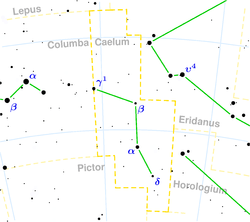Delta Caeli
Delta Caeli (δ Caeli) is a solitary,[10] blue-white hued star in the southern constellation of Caelum. It is a dim star but visible to the naked eye, having an apparent visual magnitude of +5.06.[2] Based upon an annual parallax shift of 4.63 mas as seen from Earth,[1] this star is located roughly 700 light years from the Sun. At that distance, the visual magnitude is diminished by an extinction factor of 0.13 due to interstellar dust.[5]
 Location of δ Caeli (lower middle) | |
| Observation data Epoch J2000.0 Equinox J2000.0 (ICRS) | |
|---|---|
| Constellation | Caelum |
| Right ascension | 04h 30m 50.09903s[1] |
| Declination | −44° 57′ 13.5035″[1] |
| Apparent magnitude (V) | +5.06[2] |
| Characteristics | |
| Spectral type | B2 IV-V[3] |
| U−B color index | −0.78[2] |
| B−V color index | −0.20[2] |
| Astrometry | |
| Radial velocity (Rv) | 14.2±0.8[4] km/s |
| Proper motion (μ) | RA: +1.64[1] mas/yr Dec.: −3.09[1] mas/yr |
| Parallax (π) | 4.63 ± 0.19[1] mas |
| Distance | 700 ± 30 ly (216 ± 9 pc) |
| Absolute magnitude (MV) | −1.35[5] |
| Details | |
| Mass | 7.65±0.48[6] M☉ |
| Radius | 3.9[7] R☉ |
| Luminosity (bolometric) | 2,578[6] L☉ |
| Temperature | 21,150[6] K |
| Age | 9.4±0.6[8] Myr |
| Other designations | |
| Database references | |
| SIMBAD | data |
This is a B-type star with a stellar classification of B2 IV-V,[3] where the luminosity class IV-V indicates the spectrum shows mixed traits of a subgiant star and a main sequence star. It has 7−8[6] times the mass of the Sun and about 3.9[7] times the Sun's radius. The star is around nine million years old and is radiating 2,578[6] times the Sun's luminosity from its photosphere at an effective temperature of 21,150 K.[6]
References
- van Leeuwen, F. (2007), "Validation of the new Hipparcos reduction", Astronomy and Astrophysics, 474 (2): 653–664, arXiv:0708.1752, Bibcode:2007A&A...474..653V, doi:10.1051/0004-6361:20078357.
- Hogg, A. R. (1958), "Photometric observations of 244 bright stars", Mount Stromlo Observatory Mimeogram, 2, Bibcode:1958MtSOM...2....1H.
- Houk, Nancy (1978), Michigan catalogue of two-dimensional spectral types for the HD stars, 2, Ann Arbor: Dept. of Astronomy, University of Michigan, Bibcode:1978mcts.book.....H.
- de Bruijne, J. H. J.; Eilers, A.-C. (October 2012), "Radial velocities for the HIPPARCOS-Gaia Hundred-Thousand-Proper-Motion project", Astronomy & Astrophysics, 546: 14, arXiv:1208.3048, Bibcode:2012A&A...546A..61D, doi:10.1051/0004-6361/201219219, A61.
- Gontcharov, G. A. (November 2012), "Spatial distribution and kinematics of OB stars", Astronomy Letters, 38 (11): 694–706, arXiv:1606.09028, Bibcode:2012AstL...38..694G, doi:10.1134/S1063773712110035.
- Hohle, M. M.; et al. (April 2010), "Masses and luminosities of O- and B-type stars and red supergiants", Astronomische Nachrichten, 331 (4): 349, arXiv:1003.2335, Bibcode:2010AN....331..349H, doi:10.1002/asna.200911355.
- Pasinetti Fracassini, L. E.; et al. (February 2001), "Catalogue of Apparent Diameters and Absolute Radii of Stars (CADARS)", Astronomy and Astrophysics (Third ed.), 367: 521–524, arXiv:astro-ph/0012289, Bibcode:2001A&A...367..521P, doi:10.1051/0004-6361:20000451.
- Tetzlaff, N.; et al. (January 2011), "A catalogue of young runaway Hipparcos stars within 3 kpc from the Sun", Monthly Notices of the Royal Astronomical Society, 410 (1): 190–200, arXiv:1007.4883, Bibcode:2011MNRAS.410..190T, doi:10.1111/j.1365-2966.2010.17434.x.
- "del Cae". SIMBAD. Centre de données astronomiques de Strasbourg. Retrieved 2017-09-09.
- Eggleton, P. P.; Tokovinin, A. A. (September 2008), "A catalogue of multiplicity among bright stellar systems", Monthly Notices of the Royal Astronomical Society, 389 (2): 869–879, arXiv:0806.2878, Bibcode:2008MNRAS.389..869E, doi:10.1111/j.1365-2966.2008.13596.x.